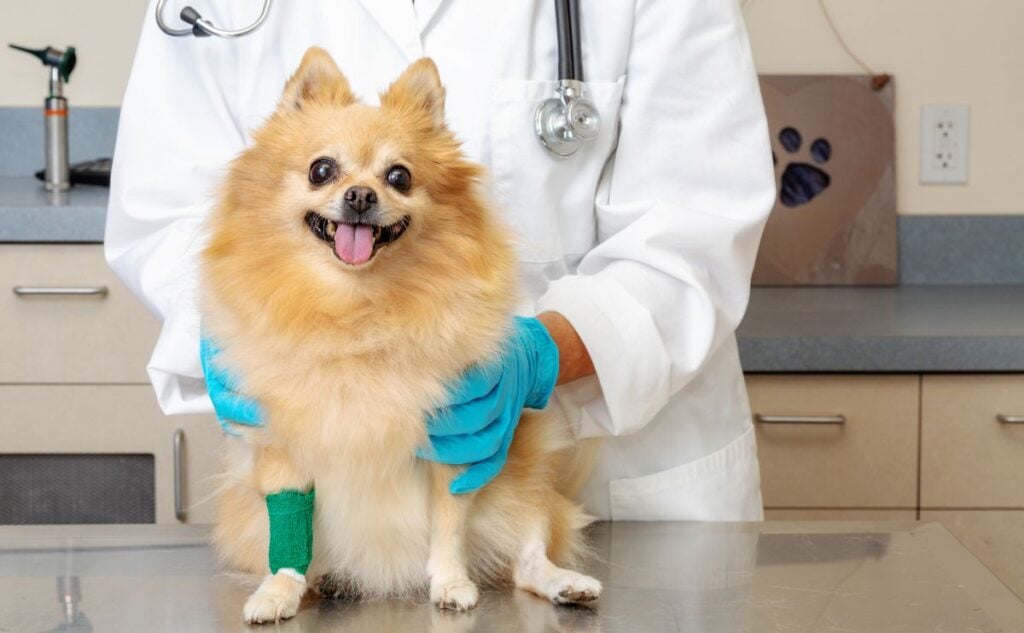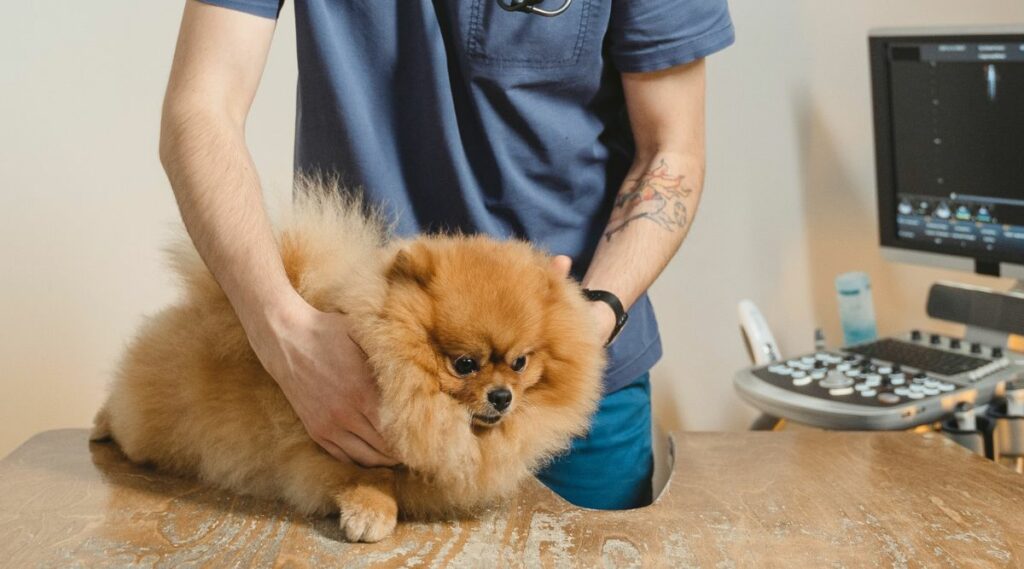10 Common Pomeranian Health Issues
When you purchase through links on our site, we may earn a commission. Here’s how it works.
For years, Pomeranians have been among the 25 most popular breeds in the U.S. They are well-known for their fox-like appearance, fluffy, thick coat, and alert expression. Although this tiny toy breed is far smaller than its Spitz-type cousins, like the Siberian Husky and Samoyed, it packs the temperament of a larger dog—feisty, energetic, playful, highly intelligent, and extremely affectionate.
Table of Contents
Despite their strong personality, their tiny size makes them prone to accidents and trauma. They’re also predisposed to several serious inherited diseases. I’ll outline the most common Pomeranian health issues and symptoms to watch out for. Often, getting vet care as soon as you notice signs of illness makes a huge difference.
10 Common Health Issues In Pomeranians
I spoke with Dr. Rebecca MacMillan, BVetMed, BSAVA, PGCertSAM, MRCVS, to gain insights from a practicing veterinarian regarding health concerns in Pomeranians. Dr. MacMillan is a veterinarian and surgeon at a small animal clinic in the U.K.
Drawing from Dr. MacMillan’s expertise and my research, I’ve compiled a list of the top 10 prevalent health issues affecting Pomeranians. It’s crucial to be aware of the symptoms associated with each condition so that you can reach out to your veterinarian promptly if you observe any signs.
1. Patellar Luxation
Research has shown that Pomeranians are among the breeds most susceptible to patellar luxation or kneecap dislocation. This condition develops when the kneecap loosens and slides out of its natural position. This limits a dog’s range of motion and keeps their knee from extending properly. Once the kneecap returns to its proper position, they can walk normally. In more than half of dogs with this condition, both hind knees are affected, and it’s usually a recurring condition.
Symptoms
- Limping
- Hopping
- Skipping
- Walking on three legs
- Stiff legs and gait
“Patellar luxation can cause intermittent limping, pain, and the early onset of arthritis, but some dogs have it to a milder degree,” says Dr. MacMillan. “Many can be managed through weight loss and physiotherapy, but others could require surgery. Vets will usually grade the severity from 1 to 4, with 1 being very mild and 4 being severe.”
I saw a Pomeranian once because she had a ‘skipping gait’. Her owners reported that she would lift a leg up for a few strides when trotting along and then place it back on the ground again. She also sometimes had a limp and stiffness, which would affect her for a few days and then ease off again after restricting her exercise.
On examination, her kneecap was easy to manipulate in and out of position, and she seemed uncomfortable in that area. We tried some anti-inflammatory painkillers initially, which helped, but the limping would come back. Her owners decided to work things up further, so after taking some X-rays, we referred her to an orthopedic surgeon.
They advised operating due to the degree of luxation and her symptoms. They performed a procedure that included deepening the groove on the front of her leg bone to prevent the kneecap from popping out of place. After a period of strict rest and a gradual return to exercise, this dog did very well.
– Dr. Rebecca MacMillan
2. Hip Disorders
Hip dysplasia and Legg-Calve-Perthes Disease (LCPD) are both common hereditary disorders affecting the hips in the Pomeranian. LCPD typically occurs between 5 and 12 months of age and causes the hip joint to collapse due to the deterioration of the femur head. Hip dysplasia occurs when the head of the femur bone doesn’t fit correctly into the hip socket. This chronic condition causes progressively increased pain and decreased mobility. These disorders often lead to arthritis.
Symptoms
- Pain or discomfort during exercise
- Lameness
- Stiff back legs
- “Bunny hop” like run
- Stiffness getting up or running
- Struggling to walk up the stairs or take long walks
- Difficulty getting up
- Muscle tone loss in back legs
- Lack of enjoyment with physical activities that were previously enjoyable
Diagnosis involves your veterinarian palpating the hip joint and performing an x-ray of the hip socket. LCPD usually requires surgery to treat. Depending on the severity of hip dysplasia, treatment options can include anti-inflammatory and pain medications, joint supplements, physical therapy, and weight management. In more advanced cases, surgery is often necessary.
3. Tracheal Collapse
“Another genetic disease that Pomeranians can suffer from is a collapsed trachea, a progressive condition where the rings of cartilage supporting the windpipe become weakened over time,” Dr. MacMillan shares. “This leads to coughing and respiratory issues.” It commonly affects Poms in middle age or senior years and is also common in other toy and small breeds such as Yorkshire Terriers and Toy Poodles.
Symptoms
Symptoms progress over time, with the last three on this list indicating a respiratory emergency.
- Persistent, dry, and honking cough
- Coughing when picked up or when pressure is applied on the neck
- Gagging, vomiting, or retching, along with coughing
- Wheezing noise when breathing in
- Difficulty breathing
- Gums or tongue turning blue
- Fainting
Diagnosing tracheal collapse includes a physical examination, chest X-ray, fluoroscopy, which is an X-ray that creates a real-time moving image as your dog breathes in and out, and a bronchoscopy (under general anesthesia), which uses a fiber optic camera to go inside the trachea and airway.
While there is no cure, medical management is typically effective. Treatment may include cough suppressants, corticosteroids, bronchodilators, sedatives or anti-anxiety medications, and antibiotics if infections occur. To help reduce inflammation and control coughing, your vet may also recommend weight loss, switching from a collar to a dog harness for walks, and avoiding hot and humid environments.
4. Hypoglycemia
Due to their small size and fast metabolism, Poms are susceptible to blood glucose levels suddenly dropping (hypoglycemia) when they miss a meal, overexercise, are stressed, or become ill. Hypoglycemia is particularly common in toy puppies. When it occurs, immediate veterinary treatment if necessary. If left untreated, it can lead to death.
Symptoms
- Lethargy and weakness
- Loss of appetite
- Loss of coordination
- Shaking and trembling
- Disorientation
- Vomiting
- Tremors/seizures
- Fainting, loss of consciousness
If you notice early symptoms, it’s crucial to provide your pup with corn syrup, honey, or an oral glucose solution such as Nutri-Cal (with your vet’s approval). Have these on hand in case of an episode.
Your veterinarian will conduct a comprehensive examination of your Pom and take a detailed medical history, particularly if they experience chronic hypoglycemia. Possible tests include a complete blood count, blood glucose levels, routine biochemistry, blood insulin levels, and a urinalysis. Additionally, an ultrasound might be performed to check for any tumors in the abdomen or pancreas.
For some dogs, treatment with an oral glucose solution will be enough. In more serious cases, hospitalization and intravenous (IV) fluid therapy may be needed. Diagnosis and treatment of any possible underlying medical condition, such as diabetes, Addison’s disease, a portosystemic (liver) shunt, kidney failure, cancer, and more, may also be necessary.
5. Hypothyroidism
Hypothyroidism is a chronic condition caused by the body’s failure to generate enough thyroid hormones, which slows down metabolism. This prevalent endocrine disorder typically impacts dogs in their middle age, around 6 to 7 years old, and can result in significant health problems if left untreated.
Symptoms
- Unexplained weight gain
- Lethargy
- Decreased activity level
- Abnormal hair loss without itching
- Dry, dull, brittle coat
- Skin darkening
- Recurrent infections in ears and skin
- Intolerance to cold
- Slow heart rate
Diagnosing hypothyroidism in dogs requires blood tests to assess their thyroid hormone levels. Based on other observed signs and symptoms, your veterinarian might recommend further tests to evaluate organ function. Although this condition cannot be cured, it can be effectively managed. Dogs diagnosed with hypothyroidism will need to take an oral thyroid replacement hormone for the remainder of their lives.
6. Reverse Sneezing
Poms are frequently affected by reverse sneezing. “I’ve seen a few Pomeranians over the years for this issue,” shared Dr. MacMillan. “They experience episodes of intense inward snorting, which can be quite distressing for inexperienced owners to watch. It usually resolves after a minute or two, though.”
While the exact cause for a reverse sneeze remains unclear, research indicates that irritation in the nose, sinuses, or back of the throat can lead to an episode. Typical irritants include dust, pollen, grass, nasal mites, mucus, smoke, or strong smells. It can also happen after moments of heightened excitement or stimulation.
Symptoms
Dogs typically act normal before and after an episode of reverse sneezing.
- Sudden, rapid inhalations through the nose
- Making a loud snorting or honking noise
- Gagging
- Extended neck
- Watery or bulging eyes
Your veterinarian may first eliminate other potential reasons for snorting and unusual breathing, including upper respiratory infections, tracheal collapse, foreign objects in the nasal passages or mouth, nasal tumors or polyps, and other respiratory issues.
Most dogs don’t require medication or any other treatment for reverse sneezing. However, Dr. MacMillan says that antihistamines might be effective in some cases, especially if it is happening frequently and an underlying allergy is suspected to be the trigger.
7. Skin Problems
Pomeranians frequently experience skin issues, including dry skin, Alopecia X, skin allergies, and sebaceous adenitis. Alopecia X, also called black skin disease, leads to hair loss and darkening of the skin but usually doesn’t cause itchiness. Skin allergies and sebaceous adenitis are chronic conditions necessitating ongoing care.
Symptoms
- Hair loss without itchy skin (Alopecia X)
- Darkening of the skin (Alopecia X)
- Itchy skin
- Skin flaking and scaling
- Rashes
- Skin infections
Hypothyroidism and Cushing’s disease also cause skin problems, so a vet will typically rule these conditions out. This requires blood testing, urinalysis, thyroid and adrenal hormone testing, and a skin biopsy. Your vet may also do skin testing to determine if your pup is allergic to environmental allergens. A skin biopsy will identify sebaceous adenitis.
Treating chronic skin diseases, allergies, and secondary skin infections may include oral medications, topical creams, medicated baths, and more. Many veterinarians also recommend fish oil or an allergy supplement to promote healthy skin.
8. Multiple Eye Disorders
Pomeranians can be prone to several genetic eye disorders. These issues can impact both eyes, although not always simultaneously, and some may appear at the same time. Dr. MacMillan advises that breeders should check their dogs for eye problems prior to breeding to ensure they are only mating healthy dogs.
- Cataracts: A common condition in many dogs (and humans), cataracts occur when the lens becomes firmer and less transparent. As the cataract matures, it becomes cloudy and blocks more and more light from reaching the back of the eye until vision is lost. Treatment requires surgery.
- Entropion: Entropion causes the eyelids to roll inward, rubbing the lashes on the eyeball. Signs include squinting, holding the eye shut, and excessive tearing. Treatment requires surgical correction.
- Distichiasis: An eyelid disorder, distichiasis occurs when extra eyelashes grow from the eyelid margin rather than the eyelid skin. These hairs rub against the eye surface, causing irritation and inflammation. Treatment typically involves electrolysis and surgically removing the hair follicles.
- Progressive retinal atrophy (PRA): PRA is an inherited condition that eventually leads to blindness. It is not painful, but there is no cure.
Symptoms
Unless noted above, many eye problems share similar symptoms.
- Eye sensitivity
- Squinty eyes
- Repeated blinking
- Bloodshot or cloudy eyes
- Yellow or green discharge
9. Heart Defects & Disease
Pomeranians, like many small breeds, are predisposed to some serious heart problems. These are the two most common in Poms.
Patent Ductus Arteriosus (PDA)
Patent ductus arteriosus (PDA) is a heart defect found in some Pomeranian puppies. This condition involves a persistent opening between the aorta and pulmonary artery that should close after birth. When it remains open, it can lead to fluid accumulation and increased pressure on the heart. As puppies grow, PDA can become more severe and may result in congestive heart failure, making early detection crucial.
Symptoms
- Heart murmur
- Abnormal pulse
- Excessive sleeping
- Difficulty breathing
- Exercise intolerance
- Stunted growth
During a puppy’s vet check-up, a heart murmur is often the initial indication of PDA. If a veterinarian detects a murmur, they will conduct a comprehensive cardiovascular evaluation using an echocardiogram. Additional tests like chest x-rays and a cardiac ultrasound might also be necessary. The good news is that if PDA is identified early, it can be treated effectively. The treatment options include either surgery or a less invasive procedure to close the ductus arteriosus.
Mitral Valve Disease (MVD)
As Pomeranians age, they may develop mitral valve disease. It occurs when the mitral valve, which divides the left atrium from the left ventricle, becomes compromised and fails to close correctly, resulting in blood leakage. This causes the heart to enlarge, fluid to accumulate in the lungs, and, eventually congestive heart failure. Heart failure is a leading cause of death among older Poms.
Symptoms
- Persistent coughing
- Respiratory difficulty
- Weight loss
- Diarrhea
- Fatigue or lethargy
- Intolerance to physical activity
- Blue or gray gums
- Collapse
A veterinary cardiologist diagnoses MVD using an echocardiogram, which is an ultrasound of the heart. If there’s a suspicion of heart failure, chest X-rays may be suggested to check for fluid in the lungs. The approach to treating MVD varies based on how advanced the condition is. Although surgical repair of the mitral valve is an option, it is quite invasive, unsuitable for some dogs, and can be expensive, costing around $50,000.
Unfortunately, there are no other available treatments that can halt or reverse the changes in the mitral valve since it is a progressive illness. If the heart has not yet enlarged, no treatment is needed. However, once enlargement occurs, using pimobendan can help delay heart failure in dogs with MVD. If heart failure symptoms appear, additional treatments such as diuretics or other medications to manage scar tissue, control irregular heartbeats, or provide electrolyte support may be necessary.

10. Dental Disease
Toy breeds like Pomeranians often face dental problems and periodontal disease. Their small mouths can lead to overcrowded and misaligned teeth, resulting in various oral health concerns. These issues may manifest as bad breath, tartar accumulation, tooth decay, swollen gums, and beyond. Periodontal disease can lead to significant health complications and potentially shorten your dog’s lifespan. Additionally, it can cause discomfort and affect your dog’s overall well-being.
Symptoms
- Swollen and bleeding gums
- Loss of teeth
- Bad breath
- Plaque and tartar buildup
- Difficulty eating and chewing
- Excessive drooling
- Loose and missing teeth
Your vet will check your dog’s mouth and teeth and offer treatment as necessary. This could involve deep cleaning or tooth removal if damaged or infected. Your furry friend might also require pain relief medication. To prevent dental issues, your vet will suggest regular teeth cleaning, both at home and an annual professional cleaning. Moreover, adjusting their diet can improve bad breath and enhance oral health.
7 More Pomeranian Health Concerns To Watch For
Although the following concerns may not be as common as those above, it’s essential to know other health issues your Pom could face.

- Sensitive stomach: Some Poms have frequent gastrointestinal issues, possibly due to food allergies or other causes.
- Epilepsy: Epilepsy is a neurological disorder that causes recurrent seizures due to abnormal electrical activity in the brain. The age of onset can vary from six months to six years old.
- Diabetes: Pomeranians, particularly overweight ones, are predisposed to diabetes, a chronic condition marked by the body’s inability to adequately regulate blood sugar levels.
- Cushing’s disease: This is a life-long disorder that occurs when the body produces too much cortisol.
- Bladder stones: Poms can develop a genetic issue known as hyperuricosuria, which can lead to the formation of bladder stones—crystallized minerals that can get stuck in the bladder.
- Hydrocephalus: Toy breeds with domed-shape heads are prone to hydrocephalus, a condition associated with a soft spot on their skull known as a molera. This occurs when spinal fluid builds up around the brain, which can result in symptoms such as seizures, coordination difficulties, and other neurological issues.
- Degenerative myelopathy (DM): DM is a spinal cord disease that causes progressive muscle weakness and an inability to control hind limbs, eventually leading to paralysis.
Health Statistics For Pomeranians
Here are some important statistics to consider. A breed health survey by the Orthopedic Foundation for Animals (OFA) among Pomeranian owners and breeders revealed that 29% of owners reported orthopedic issues, 25% experienced dental problems, 21% faced skin conditions, and 15% dealt with respiratory disorders.
The OFA’s 2023 testing data reveals that almost 30% of Pomeranians tested positive for patellar luxation, around 19% for hip dysplasia, over 5% for advanced cardiac issues, and 25% for at least one eye abnormality.

Consider Doing A DNA Test
You can learn more about your pup’s genetic health by doing an at-home DNA test on your Pom. These kits test for progressive retinal atrophy, degenerative myelopathy, and several rare hereditary conditions. Embark and Wisdom Panel‘s health tests are your best options. See my reviews of the best at-home dog DNA tests to learn more.
It’s important to know that these tests can indicate whether your Pomeranian is at an increased risk for certain genetic conditions, but this doesn’t mean your dog will actually develop the disease. However, being aware of this risk can assist you and your veterinarian in monitoring for any early signs of illness.
Average Costs For Several Pomeranian Health Problems
Embrace Pet Insurance lists the following conditions as the most common Pomeranian health issues this provider sees in insured pets, with the estimates based on claims paid by Embrace. All of these conditions are considered high-risk for Poms, according to Embrace.
- Patent Ductus Arteriosus: $2,500-$5,000
- Patellar Luxation: $1,500-$3,000
- Legg-Perthes Disease: $1,500-$3,000
- Entropion: $300-$1,500
Fetch Pet Insurance says of its insured Poms that walking abnormalities, gastric issues, and oral inflammation are common illnesses they cover. As reported by Fetch, the range of average costs for these health problems are:
- Walking abnormality: $2,700-$3,800
- Gastric issues: $1,600-$2,900
- Oral inflammation: $1,300-$1,800

How Pet Insurance Can Help
I’ve only touched on a few potential health issues your Pomeranian might face throughout their life. You can pay for these medical expenses out of pocket or consider getting a pet insurance plan to help manage a large portion of unplanned costs. Pet insurance can ease the difficult decision between your finances and ensuring your beloved pet gets the essential veterinary care they need in case of an emergency or a serious illness. Remember, it’s a good idea to insure your dog while they are still young, as most insurance providers do not cover pre-existing conditions. Check out our reviews of the best pet insurance providers for more information, and don’t miss our article on the best pet insurance for Pomeranians.

Frequently Asked Questions
Here are some questions our readers ask most often about Pomeranian health problems. If you don’t see yours here, ask us in the comments.
What Do Pomeranians Usually Die From?
The leading cause of death for Pomeranians in their golden years is heart failure. One of the main causes of death in younger Poms is trauma. Interestingly, the Pomeranian breed has one of the lowest rates of death due to cancer.
What Is The Life Expectancy Of A Pomeranian?
The typical lifespan of a Pom ranges from 14 to 16 years. Nonetheless, various factors can influence each dog’s longevity, such as genetics, general health, and lifestyle.
What’s The Best Diet For Pomeranians?
Because Poms are prone to so many health issues, feeding them the healthiest diet possible can help keep symptoms at bay and boost their immune systems to fight off their risk for illnesses and infections. See our top picks for the best dog food for Pomeranians in all life stages. You may also want to check out the best dog food for sensitive stomachs if your Pom has digestive issues.
Joint Supplements For Pomeranians
In addition to feeding your pup healthy, high-quality dog food, you may want to consider adding a daily joint supplement to your furry friend’s diet. The best dog joint supplements and arthritis supplements for dogs may help reduce the symptoms and severity of joint problems. As with all supplements, you should first get your vet’s approval.



